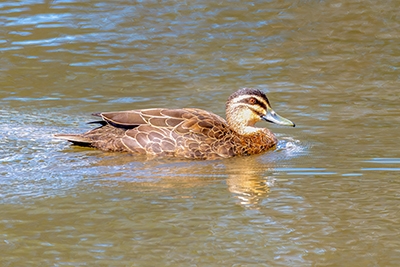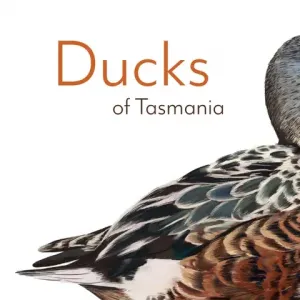Wildlife
In Meander Valley, we live alongside an incredible diversity of native wildlife, from shy bandicoots and foraging echidnas to soaring eagles and the ever-curious platypus. These animals aren’t just part of the landscape, they belong here as much as we do. But they need our care. When you’re out exploring, stick to marked tracks, observe from a distance, and keep pets under control. Feeding wildlife can do more harm than good, and even small disturbances can affect their survival.
Living with Wildlife in Meander Valley
In Meander Valley, we share our trails, townships and backyards with a rich variety of native wildlife.

Feeding native animals, like ducks, possums or wallabies, might seem kind, but it can do more harm than good. It changes their behaviour, spreads disease, and leads to poor nutrition. Even scraps like bread or fruit can cause illness or attract pests. Wildlife in Meander Valley are best left to forage naturally, just as they’ve always done.
The best thing we can offer is space, respect and a chance to stay wild.
Learn more about keeping our wildlife wild here.
Bonorong Wildlife Sanctuary
For injured or orphaned wildlife, call 0447 264 625 any time of the day or night.
For more information on Bonorong Wildlife Sanctuary, please visit their website.
Responsible dog and cat ownership plays a big role in protecting Meander Valley’s wildlife. Unrestrained pets can chase, injure or kill native animals, damage habitats and disturb nesting sites.
To help our local wildlife thrive:
• Keep dogs securely fenced and on-lead in public unless in a designated off-lead area
• Always pick up after your dog to protect waterways and public spaces
• Register and microchip your pets so they can be safely returned if lost
• Keep cats indoors or in outdoor enclosures, especially overnight when native species are most active
Being a responsible pet owner helps protect the wildlife that makes this place special.
Caring for your pets means caring for our wildlife. Discover how to be a responsible owner in Meander Valley here.
From the misty forests of Liffey Falls to the alpine edge of the Western Tiers, Meander Valley is home to some of Tasmania’s most delicate ecosystems. Stepping off track might seem harmless, but it can damage slow-growing plants, erode fragile soils, and spread diseases like root rot.
That’s why Tasmania Parks and Wildlife asks all walkers to stay on marked trails, even when they’re muddy, and avoid creating new paths or shortcuts.
Learn more about leaving no trace here.
To report roadkill on council owned roads please contact us through our website, send us an email at mail@mvc.tas.gov.au or via phone on 03 6393 5300.
To report roadkill on state highways and roads please call the Department of State Growth (Transport) on 1300 135 513.
Let Wild Ducks Stay Wild
Helping our native ducks thrive means protecting their space. Introduced breeds - like domestic mallards, geese and other dumped poultry - are louder, bolder, and more aggressive. They muscle in on habitat and food, leaving native ducks to struggle. By not feeding any waterfowl and avoiding new introductions, we give native species the best chance to flourish.

Responsible ownership starts at home. To help protect our native waterfowl and waterways, domestic ducks and geese should always be kept safely confined to your property. A secure, well-maintained enclosure with clean water and regular waste management keeps your birds healthy and prevents them from wandering into nearby rivers, parks or reserves where they can cause harm to local wildlife.
To find out more on responsible livestock and poultry ownership in Meander Valley, head over to our Poultry & Livestock page.
Releasing domestic waterfowl into the wild might seem harmless, but it puts serious pressure on our native ducks. These birds compete for food, trample habitat and can breed with native species, risking the future of our native wildlife.
If you’ve seen someone dumping ducks or geese, please report it. You can contact council through our website, by email at mail@mvc.tas.gov.au or via phone on 03 6393 5300
Feeding waterfowl may feel kind, but it tips the balance. Introduced breeds – like geese and domestic mallards – are louder, larger, and pushier. They outcompete our quiet native ducks for space and food. Take away the food, and introduced birds are more likely to move on.
To help our native species thrive, resist the urge to feed. Instead, linger by the riverbank. Watch their gentle paddles, their soft dives, their hidden nests. Learn their names. Spot their colours. Let your curiosity be the gift you give.
With the vibrant Meander River running for over 112 kilometres through the heart of our valley, we’re home to an abundance of native waterfowl. Pacific Black Ducks, Australian Shelducks and Australian Wood Ducks are just some of the striking species that call the Meander River, its catchments and neighbouring waterways home.
Mallards and Pacific Black Ducks
When mallards are released or escape into the wild, they don’t just outcompete native ducks, they interbreed with them. The result is hybrid offspring, and over time, fewer and fewer pure Pacific Black Ducks remain. This process, called introgressive hybridisation, slowly erodes the unique traits that define our native duck.

The saddest part? It’s preventable.
Every time you choose not to feed feral ducks, report a hybrid sighting, or call out duck dumping, you’re giving our native species a fighting chance.
If you need help identifying if a duck is native, a domestic mallard or mallard hybrid, you can send a photo to Pacific Black Duck Conservation Group at pacificblackduck@landcaretas.org.au or see the Facebook group: Pacific Black Duck Conservation Group | Facebook
Information on living with ducks can be found on the Department of Natural Resources and Environment Tasmania website.
Learn about Tasmania's 11 native duck species and how you can help keep them safe.
Keen to spread the word?
Download our Do Not Feed the Ducks & Geese flyer and help protect the quiet lives of our native ducks.
More Ways to Protect What We Love
Landcare Tasmania
Landcare Tasmania connects everyday people who care about their patch, from planting native trees to protecting local wildlife and cleaning up rivers. With over 300 volunteer groups across the state, it’s all about locals working together to look after land, water and community.
We have a plethora of incredible community groups run through Landcare Tasmania here in the Meander Valley. Find your nearest Landcare Group here to get involved.
Pacific Black Duck Conservation Group
This community-led group is dedicated to protecting native waterbirds, especially the Pacific Black Duck, from the growing threat of cross-breeding with introduced domestic mallards. Run by volunteers and supported by Landcare Tasmania, the group shares sightings, encourages citizen science, and works with councils to manage feral duck populations.
Join the conversation and take part at Pacific Black Duck Conservation Group on Facebook or get in touch via pacificblackduck@gmail.com.
iNaturalist
Ever spotted something wild and wondered what it was?
iNaturalist is a free app that helps you identify plants, animals, and fungi by simply snapping a photo. Each sighting becomes part of a global record, and here in Meander Valley, that means your observations can help build a clearer picture of the life that calls this patch home. Whether you’re out on a walk, in the garden or by the river, every record adds to our shared knowledge and care for the land.
Spot it. Snap it. Share it. Discover iNaturalist here.
Ebird
eBird is a simple way to share what you see in the skies and treetops. Whether you’re a keen twitcher or just spotting a blue wren on your morning stroll, every record helps build a picture of the birds that call this patch of ours home. Your sightings feed into a global database used by researchers, landcarers and communities to better understand how our birdlife is changing and how we can help it thrive.
Discover how your bird sightings can make a difference, explore eBird here.
Birdata
Birdata is BirdLife Australia’s national bird monitoring platform, where everyday sightings help shape real conservation outcomes. Whether you're watching wrens in the garden or counting cockatoos in the paddock, your observations feed into vital research that protects species and habitats across the country. It’s easy, rewarding and open to all.
Start surveying and explore the world of Birdata here.

